This PDF is a selection from an out-of-print volume from the National
Bureau of Economic Research
Volume Title: Term Lending to Business
Volume Author/Editor: Neil H. Jacoby and Raymond J. Saulnier
Volume Publisher: NBER
Volume ISBN: 0-870-14129-5
Volume URL: http://www.nber.org/books/jaco42-1
Publication Date: 1942
Chapter Title: Summary of Findings
Chapter Author: Neil H. Jacoby, Raymond J. Saulnier
Chapter URL: http://www.nber.org/chapters/c5749
Chapter pages in book: (p. 1 - 8)
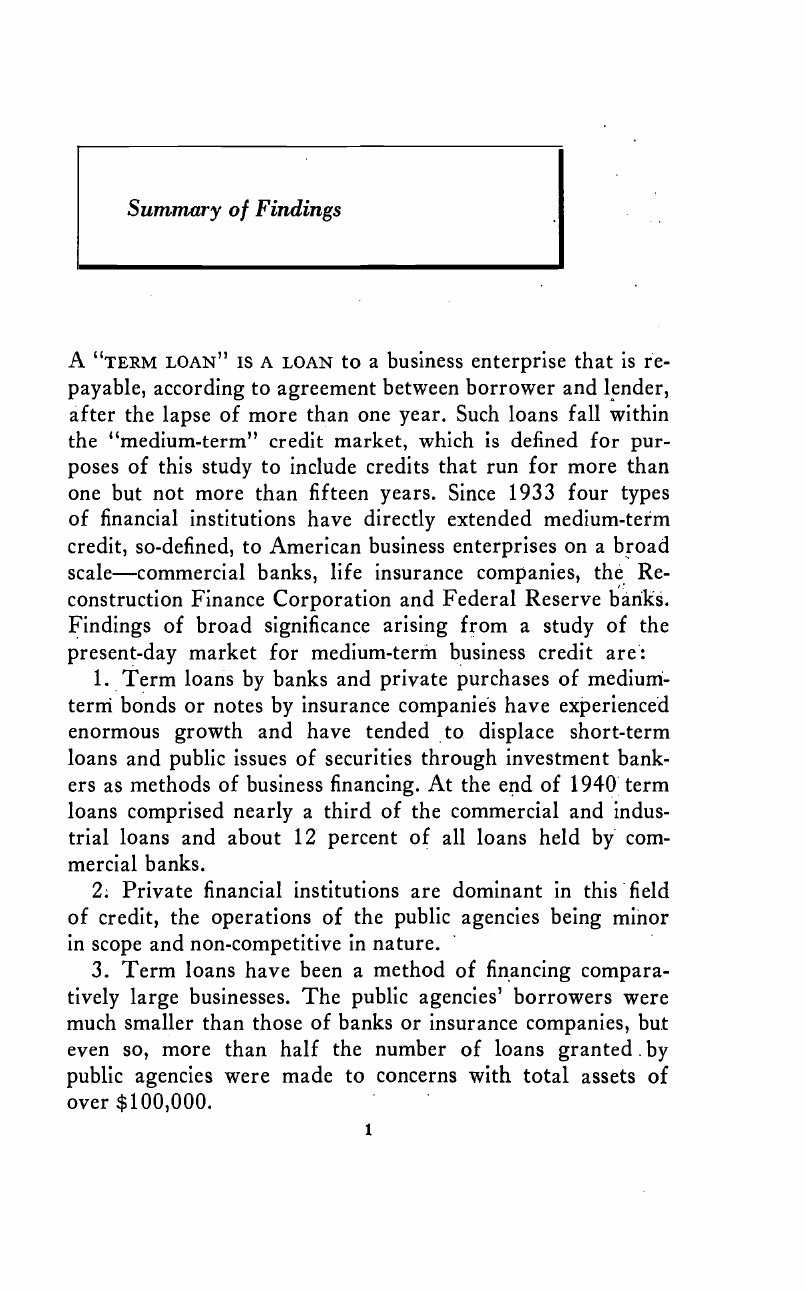
Summary of Findings
A "TERM LOAN" IS A LOAN to a business enterprise that is re-
payable, according to agreement between borrower and lender,
after the lapse of more than one year. Such loans fall within
the "medium-term" credit market, which is defined for pur-
poses of this study to include credits that run for more than
one but not more than fifteen years. Since 1933 four types
of financial institutions have directly extended medium-term
credit, so-defined, to American business enterprises on a broad
scale—commercial banks, life insurance companies, the Re-
construction Finance Corporation and Federal Reserve banks.
Findings of broad significance arising from a study of the
present-day market for medium-term business credit are:
1. Term loans by banks and private purchases of medium-
term bonds or notes by insurance companies have experienced
enormous growth and have tended to. displace short-term
loans and public issues of securities through investment bank-
ers as methods of business financing. At the end of 1940 term
loans comprised nearly a third of the commercial and indus-
trial loans and about 12 percent of all loans held by com-
mercial banks.
Private financial institutions are dominant in this field
of credit, the operations of the public agencies being minor
in scope and non-competitive in nature.
3. Term loans have been a method of financing compara-
tively large businesses. The public agencies' borrowers were
much smaller than those of banks or insurance companies, bu.t
even so, more than half the number of loans granted by
public agencies were made to concerns with total assets of
over $100,000.
1
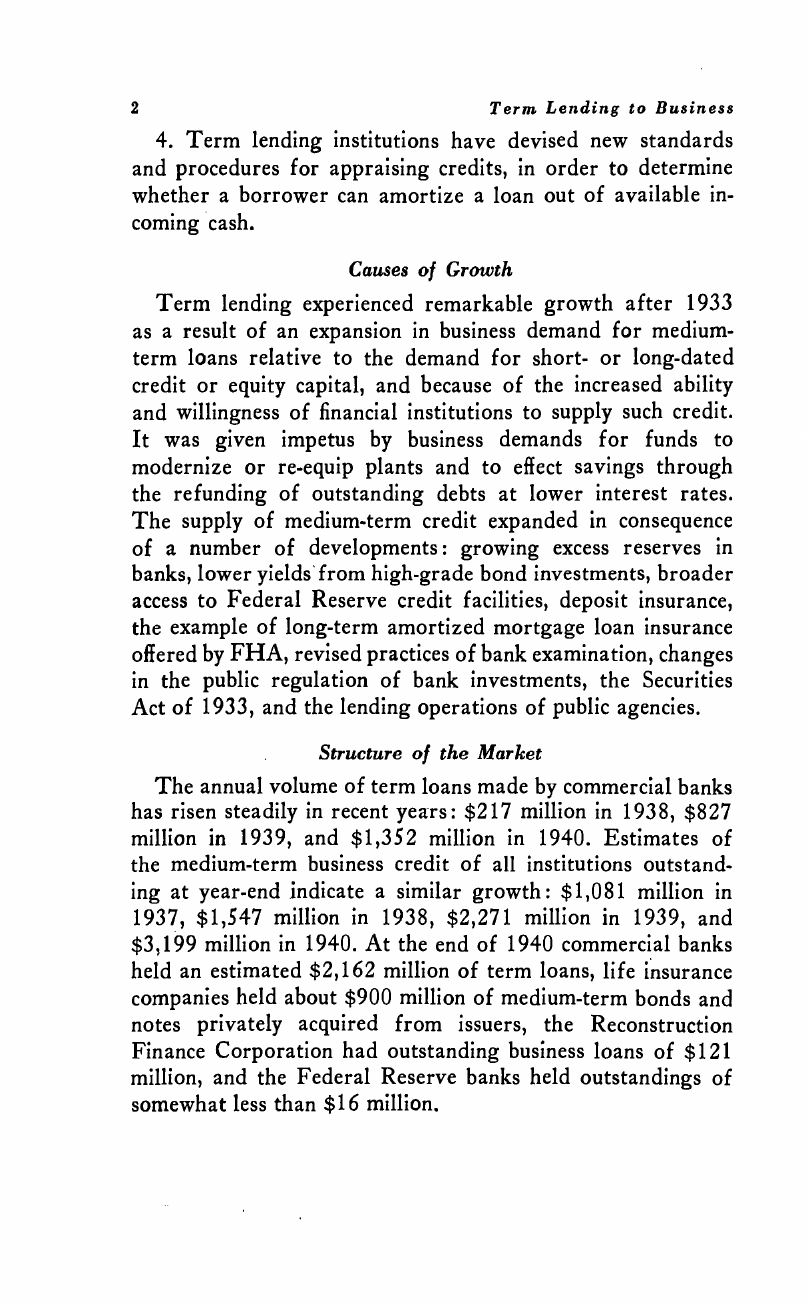
2
Term
Lending to Business
4. Term lending institutions have devised new standards
and procedures for appraising credits, in order to determine
whether a borrower can amortize a loan out of available in-
coming cash.
Causes of Growth
Term lending experienced remarkable growth after 1933
as a result of an expansion in business demand for medium-
term loans relative to the demand for short- or long-dated
credit or equity capital, and because of the increased ability
and willingness of financial institutions to supply such credit.
It was given impetus by business demands for funds to
modernize or re-equip plants and to effect savings through
the refunding of outstanding debts at lower interest rates.
The supply of medium-term credit expanded in consequence
of a number of developments: growing excess reserves in
banks, lower yields from high-grade bond investments, broader
access to Federal Reserve credit facilities, deposit insurance,
the example of long-term amortized mortgage loan insurance
offered by FHA, revised practices of bank examination, changes
in the public regulation of bank investments, the Securities
Act of 1933, and the lending operations of public agencies.
Structure of the Market
The annual volume of term loans made by commercial banks
has risen steadily in recent years: $217 million in 1938, $827
million in 1939, and $1,352 million in 1940. Estimates of
the medium-term business credit of all institutions outstand-
ing at year-end indicate a similar growth: $1,081 million in
1937,
$1,547 million in 1938, $2,271 million in 1939, and
$3,199 million in 1940. At the end of 1940 commercial
banks
held
an estimated $2,162 million of term loans, life insurance
companies held about $900 million of medium-term bonds and
notes privately acquired from issuers,
the Reconstruction
Finance Corporation had outstanding business loans of $121
million, and the Federal Reserve banks held outstandings of
somewhat less than $16 million.
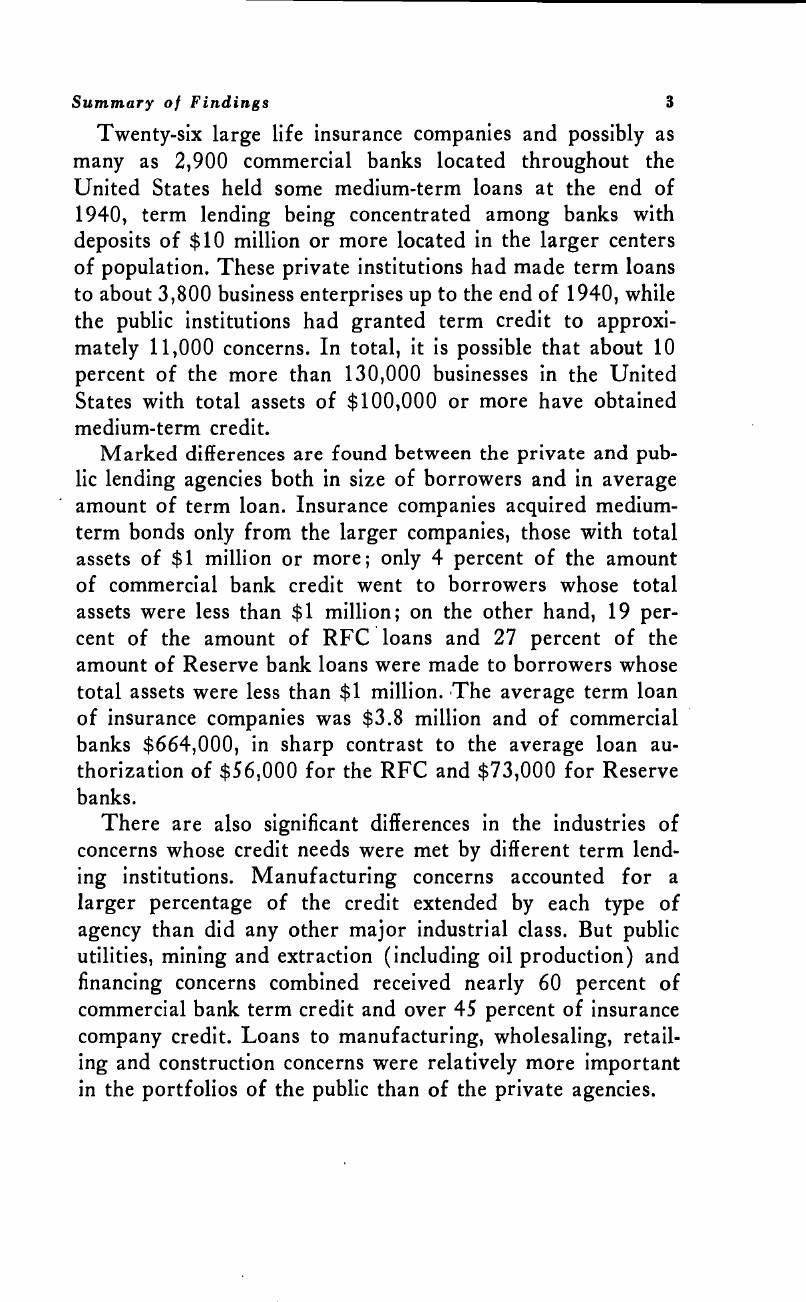
Summary of Findings
3
Twenty-six
large life insurance companies and possibly as
many as 2,900 commercial banks located throughout the
United States held, some medium-term loans at the end of
1940, term lending being concentrated among banks with
deposits of $10 million or more located in the larger centers
of population. These private institutions had made term loans
to about 3,800 business enterprises up to the end of 1940, while
the public institutions had granted term credit to approxi-
mately 11,000 concerns. In total, it is possible that about 10
percent of the more than 130,000 businesses in the United
States with total assets of $100,000 or more have obtained
medium-term credit.
Marked differences are found between the private and pub-
lic lending agencies both in size of borrowers and in average
amount of term loan. Insurance companies acquired medium-
term bonds only from the larger companies, those with total
assets of $1 million or more; only 4 percent of the amount
of commercial bank credit went to borrowers whose total
assets were less than $1 million; on the other hand, 19 per-
cent of the amount of RFC loans and 27 percent of the
amount of Reserve bank loans were made to borrowers whose
total assets were less than $1 million. The average term loan
of insurance companies was $3.8 million and of commercial
banks $664,000, in sharp contrast to the average loan au-
thorization of $56,000 for the RFC and $73,000 for Reserve
banks.
There are also significant differences in the industries of
concerns whose credit needs were met by different term lend-
ing institutions. Manufacturing concerns accounted for a
larger percentage of the credit extended by each type of
agency than did any other major industrial class. But public
utilities, mining and extraction (including oil production) and
financing concerns combined received nearly 60 percent of
commercial bank term credit and over 45 percent of insurance
company credit. Loans to manufacturing, wholesaling, retail-
ing and construction concerns were relatively more important
in the portfolios of the public than of the private agencies.
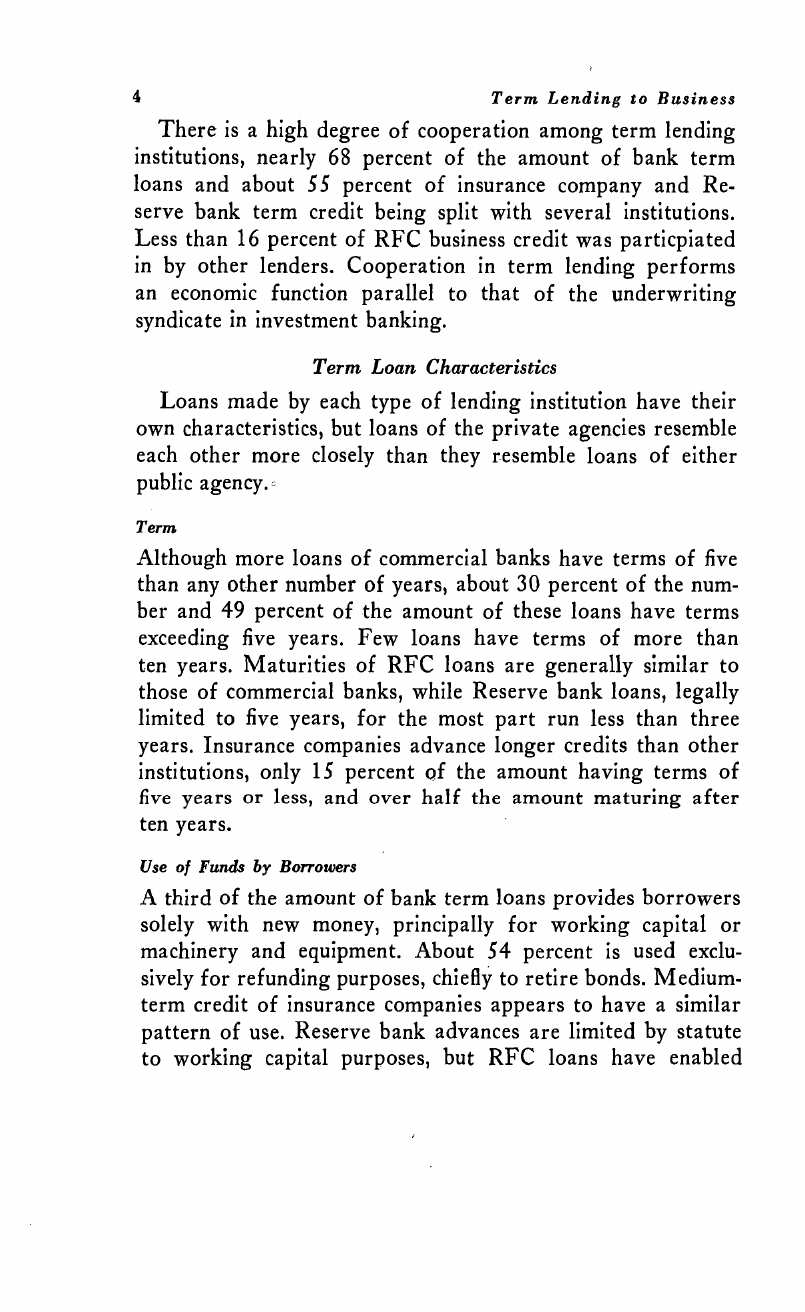
4
Term Lending to Business
There is a high degree of cooperation among term lending
institutions, nearly 68 percent of the amount of bank term
loans and about 55 percent of insurance company and Re-
serve bank term credit being split with several institutions.
Less than 16 percent of RFC business credit was particpiated
in by other lenders. Cooperation in term lending performs
an economic function parallel to that of the underwriting
syndicate in investment banking.
Term Loan Characteristics
Loans made by each type of lending institution have their
own characteristics, but loans of the private agencies resemble
each other more closely than they resemble loans of either
public agency.
Term
Although more loans of commercial banks have terms of five
than any ot.her number of years, about 30 percent of the num-
ber and 49 percent of the amount of these loans have terms
exceeding five years. Few loans have terms of more than
ten years. Maturities of RFC loans are generally similar to
those of commercial banks, while Reserve bank loans, legally
limited to five years, for the most part run less than three
years. Insurance companies advance longer credits than other
institutions, only 15 percent of the amount having terms of
five years or less, and over half the amount maturing after
ten years.
Use of Funds by Borrowers
A third of the amount of bank term loans provides borrowers
solely with new money, principally for working capital or
machinery and equipment. About 54 percent is used exclu-
sively for refunding purposes, chiefly to retire bonds. Medium-
term credit of insurance companies appears to have a similar
pattern of use. Reserve bank advances are limited by statute
to working capital purposes, but RFC loans have enabled
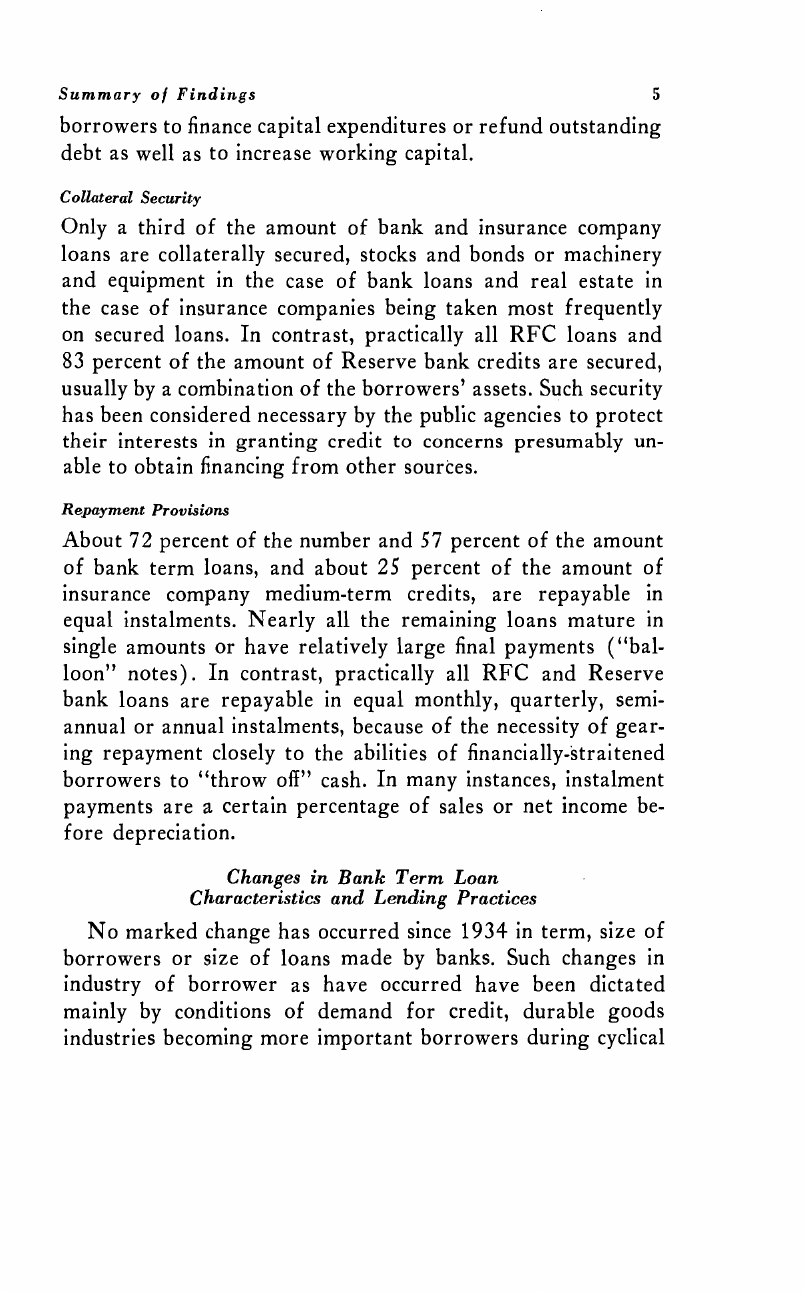
Summary of Findings
5
borrowers to finance capital expenditures or refund outstanding
debt as well as to increase working capital.
Collateral Security
Only a third of the amount of bank and insurance company
loans are collaterally secured, stocks and bonds or machinery
and equipment in the case of bank loans and real estate in
the case of insurance companies being taken most frequently
on secured loans. In contrast, practically all RFC loans and
83 percent of the amount of Reserve bank credits are secured,
usually by a combination of the borrowers' assets. Such security
has been considered necessary by the public agencies to protect
their interests in granting credit to concerns presumably un-
able to obtain financing from other sources.
Repayment Provisions
About 72 percent of the number and 57 percent of the amount
of bank term loans, and about 25 percent of the amount of
insurance company medium-term credits, are repayable in
equal instalments. Nearly all the remaining loans mature in
single amounts or have relatively large final payments ("bal-
loon" notes). In contrast, practically all RFC and Reserve
bank loans are repayable in equal monthly, quarterly, semi-
annual or annual instalments, because of the necessity of gear-
ing repayment closely to the abilities of financially-straitened
borrowers to "throw off" cash. In many instances, instalment
payments are a certain percentage of sales or net income be-
fore depreciation.
Changes in Bank Term Loan
Characteristics and Lending Practices
No marked change has occurred since 1934 in term, size of
borrowers or size of loans made by banks. Such changes in
industry of borrower as have occurred have been dictated
mainly by conditions of demand for credit, durable goods
industries becoming more important borrowers during cyclical

6
Term Lending to Business
upswings. However, banks are tending to dispense with col-
lateral security, to insist upon amortization of loans in equal
instalments, to split loans among several lenders, and to in-
crease the proportion of credit devoted to business expansion.
Term Lending Operations of Banks
Few banks have set up separate organizations to handle
term loans, but they have frequently employed personnel
trained in long-term investment credits and have assigned the
task of credit analysis to analytical units connected with bond
or trust departments.
Term loans are generally accompanied by agreements,
"tailor-made" to fit the circumstances of each borrower, con-
taining restrictions on the borrower's indebtedness, requiring
maintenance of certain minimum financial conditions,
sub-
jecting management personnel and capital expenditures to con-
trol of the lender, requiring the keeping of accurate books and
records, providing for acceleration of the debt under certain
circumstances, and specifying any collateral security that may
be required.
Credit standards applied by banks relate mainly to the earn-
ing power of a business, whereas those of the RFC and Re-
serve banks necessarily lay relatively greater stress upon
collateral security. In determining whether applicants meet
their credit standards, all agencies conduct thorough investi-
gations and prepare analyses both of financial statements over
the past seven or more years and of the efficiency of the
applicant's production facilities and marketing methods in
relation to those of other concerns in the industry.
Term loans at the end of 1940 formed 22 percent of all
loans held by 50 large commercial banks, and 30 percent or
more of all loans held by five of the largest banks. They com-
prised well over half of the commercial and industrial loans
held by these 50 institutions. The industrial character of its
territory and the attitudes and training of its personnel are
crucial factors in determining the amount of term loans a bank
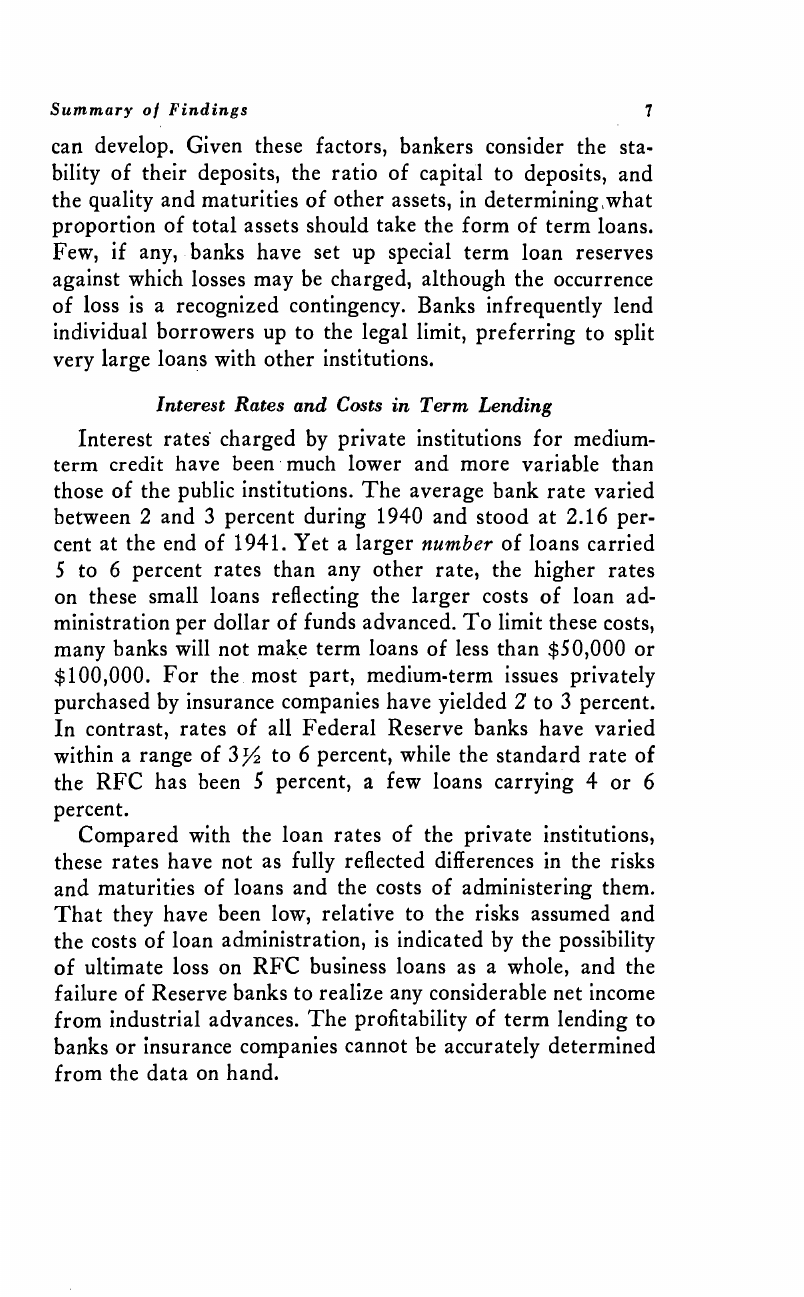
Summary o/ Findings
7
can develop. Given these factors, bankers consider the sta-
bility of their deposits, the ratio of capital to deposits, and
the quality and maturities of other assets, in determining what
proportion of total assets should take the form of term loans.
Few, if any, banks have set up special term loan reserves
against which losses may be charged, although the occurrence
of loss is a recognized contingency. Banks infrequently lend
individual borrowers up to the legal limit, preferring to split
very large loans with other institutions.
Interest Rates and Costs in Term Lending
Interest rates charged by private institutions for medium-
term credit have been much lower and more variable than
those of the public institutions. The average bank rate varied
between 2 and 3 percent during 1940 and stood at 2.16 per-
cent at the end of 1941. Yet a larger number of loans carried
5 to 6 percent rates than any other rate, the higher rates
on these small loans reflecting the larger costs of loan ad-
ministration per dollar of funds advanced. To limit these costs,
many banks will not make term loans of less than $50,000 or
$100,000. For the, most part, medium-term issues privately
purchased by insurance companies have yielded 2 to 3 percent.
In contrast, rates of all Federal Reserve banks have varied
within a range of 35/2
to 6 percent, while the standard rate of
the RFC has been 5 percent, a few loans carrying 4 or 6
percent.
Compared with the loan rates of the private institutions,
these rates have not as fully reflected differences in the risks
and maturities of loans and the costs of administering them.
That they have been low, relative to the risks assumed and
the costs of loan administration, is indicated by the possibility
of ultimate loss on RFC business loans as a whole, and the
failure of Reserve banks to realize any considerable net income
from industrial advances. The profitability of term lending to
banks or insurance companies cannot be accurately determined
from the data on hand.
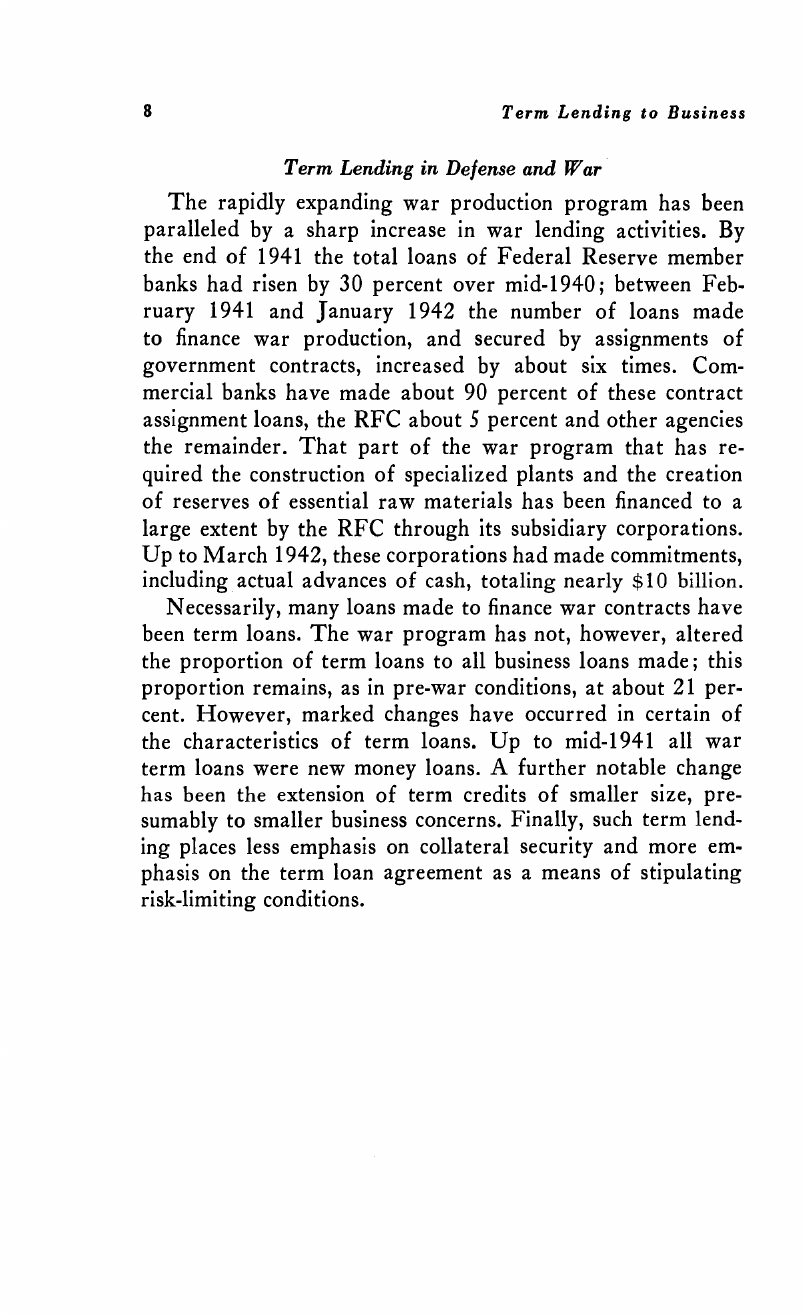
8
Term
Lending to Business
Term Lending in Defense and War
The rapidly expanding war production program has been
paralleled by a sharp increase in war lending activities. By
the end of 1941 the total loans of Federal Reserve member
banks had risen by 30 percent over mid-1940; between Feb-
ruary 1941 and January 1942 the number of loans made
to finance war production, and secured by assignments of
government contracts, increased by about six times. Com-
mercial banks have made about 90 percent of these contract
assignment loans, the RFC about 5
percent and other agencies
the remainder. That part of the war program that has re-
quired the construction of specialized plants and the creation
of reserves of essential raw materials has been financed to a
large extent by the RFC through its subsidiary corporations.
Up to March 1942, these corporations had made commitments,
including actual advances of cash, totaling nearly $10 billion.
Necessarily, many loans made to finance war contracts have
been term loans. The war program has not, however, altered
the proportion of term loans to all business loans made; this
proportion remains, as in pre-war conditions, at about 21 per-
cent. However, marked changes have occurred in certain of
the characteristics of term loans. Up to mid-1941 all war
term loans were new money loans. A further notable change
has been the extension of term credits of smaller size, pre-
sumably to smaller business concerns. Finally, such term lend-
ing places less emphasis on collateral security and more em-
phasis on the term loan agreement as a means of stipulating
risk-limiting conditions.
